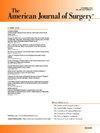Revisional Roux-en-Y gastric bypass after gastric banding leads to sustainable and significant additional weight loss regardless of Roux limb length
IF 2.7
3区 医学
Q1 SURGERY
引用次数: 0
Abstract
Introduction
The aim of this study is to compare the outcomes between patients undergoing very-very long limb RYGB (VVLL-RYGB) and proximal RYGB (PRYGB) after adjustable gastric banding (LAGB).
Methods
All patients undergoing conversion from LAGB to RYGB in a bariatric reference center between 2010 and 2016 were analyzed.
Results
Sixty-six patients (80 % female, mean age 44.5 ± 9 years, pre-revisional BMI 40.2 ± 7.4 kg/m2) underwent conversion from LAGB to VVLL-RYGB, and 26 patients (88 % female, mean age 46.9 ± 7.6 years, pre-revisional BMI 37.2 ± 5.3 kg/m2) to PRYGB. ΔBMI 5 years after conversion was 8.2 ± 6.1 kg/m2 in VVLL-RYGB compared to 6.7 ± 5.1 kg/m2 in PRYGB (p = 0.35). There was no significant difference in long-term morbidity. Further revisional procedures after VVLL-RYGB occurred in 10 (15.1 %) and 8 (30.8 %) after PRYGB (p = 0.136).
Conclusion
VVLL-RYGB and PRYGB after LAGB are safe and lead to significant and sustainable additional weight loss without difference in BMI loss between the procedures after 5 years.
胃束带术后复查Roux-en- y胃旁路术,无论Roux肢体长度如何,均可导致持续且显著的额外体重减轻
本研究的目的是比较可调节胃束带(LAGB)后行超长肢RYGB (VVLL-RYGB)和近端RYGB (PRYGB)患者的预后。方法对2010 - 2016年在某体重参考中心接受LAGB向RYGB转化的所有患者进行分析。结果66例患者(女性80%,平均年龄44.5±9岁,修正前BMI 40.2±7.4 kg/m2)从LAGB转换为VVLL-RYGB, 26例患者(女性88%,平均年龄46.9±7.6岁,修正前BMI 37.2±5.3 kg/m2)转换为PRYGB。ΔBMI转换后5年VVLL-RYGB为8.2±6.1 kg/m2,而PRYGB为6.7±5.1 kg/m2 (p = 0.35)。两组长期发病率无显著差异。VVLL-RYGB术后10例(15.1%),PRYGB术后8例(30.8%)进一步复查(p = 0.136)。结论vvll - rygb和PRYGB在LAGB后是安全的,并且在5年后两种方法之间的BMI下降无差异,可导致显著和持续的额外体重减轻。
本文章由计算机程序翻译,如有差异,请以英文原文为准。
求助全文
约1分钟内获得全文
求助全文
来源期刊
CiteScore
5.00
自引率
6.70%
发文量
570
审稿时长
56 days
期刊介绍:
The American Journal of Surgery® is a peer-reviewed journal designed for the general surgeon who performs abdominal, cancer, vascular, head and neck, breast, colorectal, and other forms of surgery. AJS is the official journal of 7 major surgical societies* and publishes their official papers as well as independently submitted clinical studies, editorials, reviews, brief reports, correspondence and book reviews.

 求助内容:
求助内容: 应助结果提醒方式:
应助结果提醒方式:


